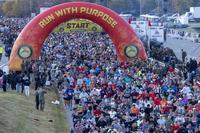Finding a swimming pool can be a challenge in many areas around the country. Finding one that matches the dimensions of your testing facility's pool can be even tougher.
Here is a question from an Air Force Special Warfare candidate who is seeking to ace his swim test but has to practice in a pool that's not the same size as the one he'll be using for his test.
I have an Air Force Initial Fitness Test (IFT) for their Special Warfare program coming up and they are holding it in a 50-meter pool. I've been used to swimming in a 25-yard pool because it's all that's close to my area. Will it make a difference? If so, how can I better prepare myself? -- Thank you, sir.
The short answer is yes, you will be slower in a longer pool for the IFT. But there is good news and bad news regarding the length of the pool in timed swimming events. Mainly due to the number of kicks off the walls you get in a 25-yard or 25-meter short pool versus the 50-yard or 50-meter longer pool setup, your speed will increase immediately off the wall if you have a good form, a streamlined body position and a powerful kick and pull out.
Typically, the longer course will increase times by 20 to 40 seconds without fins. Scuba fins can make the kickoffs awkward, and you will find you are faster with scuba fins on the longer course with fewer turnarounds.
Some Things to Practice
Hard Workouts
You should still mix in fast swim pacing workouts, treading water, and pool deck PT with your swim workouts regardless of the size of the pool. These help develop the aquatic conditioning needed for various military dive and rescue swimmer programs like Air Force Special Warfare, Army Combat Dive School, Coast Guard and Navy Rescue Swimmer Schools, Marine RECON/MarSOC, and Navy SEAL, EOD and Dive School.
Good Streamlined Body Position and Breaststroke Pullouts
The kicks off the walls still matter and are important in building momentum with every turnaround in a pool. Though you will never be faster in a 500-meter swim test than you are in the 5 meters after every kick off the wall, the key is to not lose your momentum once you start to transition into the swim stroke you are testing (freestyle, CSS, side stroke, breaststroke).
Practice the powerful kick off the wall while in a tight, streamlined body position and then film yourself to see whether you lose your momentum or stop in the water as you transition into the stroke. Many non-swimming athletes who are taking this test often lose momentum during the swim test because of three common errors:
- Weak Kick and Streamlined Position Off the Wall. By not producing a powerful kick and tight, streamlined position or by pulling the arms too quickly off the wall, you lose out on the "free distance" you get with little to no effort other than a short breath hold. A proper and powerful "breaststroke pullout" is the key to your success, no matter how long the pool might be.
- Overgliding. If you hold the glide position for too long, you will eventually quit moving and then you must recreate momentum again with the next stroke. You may be able to get 5 seconds of glide time off the wall if the power and streamlined positioning is correct. During the CSS stroke (commonly used in these special ops tests), the common glide time is less than 3 seconds after the kick.
- Popping Head Up to Breathe. If you are doing freestyle, side stroke, or CSS, you want to turn your head to breathe. Do not pop your head up to breathe, as you can lose horizontal movement when you go vertical to breathe. Your body acts like a seesaw when your head pops up, since the legs tend to drop, causing a diagonal swim position. This is much less effective than being in a horizontal body position in the pool.
In the end, the size of the pool in which you're going to be tested should not matter. Eventually, most of your swims in the AFSW Prep Course and Assessment and Selection will be in a longer course swim, mostly with scuba fins. Make sure you meet the standards of the 500-meter by training yourself to finish the distance at least 2 minutes faster than the minimum standards. If you're able to do that, the length of the testing course won't matter. Do not neglect swimming with fins, as most of your training swims will be done with scuba fins.
-- Stew Smith is a former Navy SEAL and fitness author certified as a Strength and Conditioning Specialist (CSCS) with the National Strength and Conditioning Association. Visit his Fitness eBook store if you're looking to start a workout program to create a healthy lifestyle. Send your fitness questions to stew@stewsmith.com.
Want to Learn More About Military Life?
Whether you're thinking of joining the military, looking for fitness and basic training tips, or keeping up with military life and benefits, Military.com has you covered. Subscribe to Military.com to have military news, updates and resources delivered directly to your inbox.


















